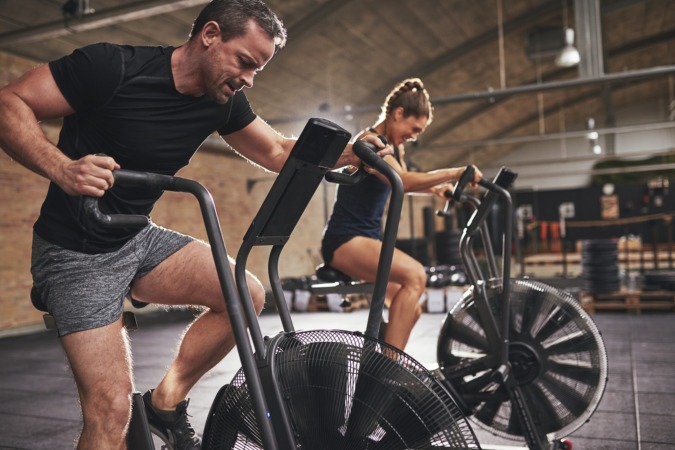
Cardiovascular training encompasses a wide range of exercises that impact your heart, lungs, and blood vessels. Essentially, any activity that elevates your heart rate and breathing falls under the cardio category.
While all forms of cardio contribute to fat burning, fitness improvement, and overall health, there are two primary classifications worth exploring: High-Intensity Interval Training (HIIT) and Low-Intensity Steady-State (LISS).
These two types of cardio vary greatly in intensity and come with distinct advantages and disadvantages. In this article, we aim to analyze HIIT and LISS comprehensively, assisting you in selecting the most suitable option for your fitness journey.
Understanding HIIT:

High-Intensity Interval Training, commonly known as HIIT, involves bursts of intense exercise followed by short periods of rest or lower-intensity activity. The number of repetitions depends on your fitness level and the specific workout but can range from as few as five to more than ten rounds.
HIIT is considered anaerobic training, meaning it pushes your body to work so vigorously that it cannot supply enough oxygen to your muscles. Typically, your heart rate reaches or even exceeds 90% of its maximum during the intense phases, followed by a partial decrease during the rest periods to enable the next repetition.
HIIT offers versatility in exercise selection, accommodating various activities such as sprinting on a bike, treadmill, or rower, as well as exercises like burpees, box jumps, power cleans, or kettlebell swings. One of the well-known HIIT protocols is Tabata training, which consists of 20-second maximum-effort intervals alternated with 10-second rest periods, totaling four minutes.
Benefits of HIIT:
- Efficient Calorie Burn: HIIT burns 20-30% more calories in a shorter time than most other forms of exercise.
- Effective for Weight Loss: When combined with a balanced diet, regular HIIT workouts have proven effective for weight loss, potentially targeting stubborn belly fat, a significant cardiovascular risk.
- Elevated Post-Exercise Metabolism: HIIT boosts post-workout metabolic rate and fat burning more than lower-intensity cardio.
- Muscle Preservation/Growth: Depending on the type of HIIT performed, it may lead to increased muscle mass or help maintain existing muscle.
- Improved Aerobic and Anaerobic Fitness: While primarily anaerobic, HIIT also positively impacts aerobic fitness, making it a highly efficient exercise method.
Understanding LISS:

Low-Intensity Steady-State, or LISS, encompasses activities where you maintain your heart rate between 60-85% of your maximum for an extended duration. This level of intensity should feel moderately comfortable, although it may become more challenging as your heart rate approaches the higher end of the range. While heart rate fluctuations are normal during LISS, the pace and intensity should remain relatively constant.
Common LISS activities include walking, jogging, running, swimming, cycling, and rowing. Group classes like step and Zumba are variations of LISS training. Typically, LISS sessions last at least 20-30 minutes and can extend up to 90 minutes or more.
Benefits of LISS:
- LISS shares many benefits with HIIT, including weight loss and improved fitness.
- It can be more enjoyable for many people, providing relaxation and opportunities for social interaction.
- LISS is generally safer for the cardiovascular system and poses lower risks.
- However, it may not be as effective at increasing post-exercise metabolism, building muscle, or improving anaerobic fitness.
Comparing HIIT and LISS:
When comparing HIIT and LISS, several key factors come into play:
- Time Efficiency: HIIT stands out as the most time-efficient option, with workouts as short as four minutes proving effective. Studies even suggest that 20 minutes of HIIT can yield similar results to much longer LISS sessions.
- Calorie Burning: HIIT burns 20-30% more calories per minute than LISS, although it can achieve similar calorie expenditure due to shorter workout durations.
- Enjoyment: LISS tends to be more enjoyable for a significant portion of exercisers, offering relaxation and social aspects, while HIIT is often intense and can be stressful.
- Safety: HIIT poses greater cardiovascular stress, potentially increasing the risk of adverse events. It can also be harder on muscles and joints, leading to a higher likelihood of acute injuries. LISS is generally safer but may lead to chronic overuse injuries.
- Body Recomposition: HIIT is better at preserving or increasing muscle mass while burning fat, while LISS may lead to muscle atrophy.
- Workout Volume and Frequency: LISS allows for longer and more frequent sessions, making it suitable for daily exercise and recovery workouts. HIIT, on the other hand, requires more significant recovery time.
- Suitability for Beginners: LISS is generally safer and better suited for beginners, while HIIT may be too intense and challenging for those just starting their fitness journey.
- Sports Specificity: HIIT is more beneficial for sports with intermittent bursts of high-intensity activity, while LISS is suitable for endurance athletes.
In conclusion, the choice between HIIT and LISS ultimately depends on your fitness goals, preferences, and circumstances.
HIIT offers a time-efficient, muscle-preserving, and intense option but may be challenging for beginners and carries higher risks.
LISS provides a more enjoyable and safer alternative, ideal for building endurance and accommodating daily exercise.
Some individuals may benefit from incorporating both methods into their fitness routine, ensuring a balanced approach that aligns with their objectives and personal preferences.





